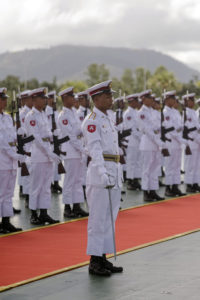Myanmar Army Escalates Combat Against Kachin Separatists
 The Tatmadaw, the Myanmar Armed Forces, intensified its weeklong offensive on the Kachin Independence Army (KIA) in the disputed Kachin State territory. The Irrawaddy, Myanmar’s primary newspaper, reported bombing key KIA positions by air on September 23. According to Radio Free Asia, the KIA reported two deaths, while the Tatmadaw reported none. Over 2000 villagers have fled to larger towns for greater safety. The Tatmadaw made similar advances in May and July. These escalations represent the latest in an intermittent six-year conflict between government forces and separatists.
The Tatmadaw, the Myanmar Armed Forces, intensified its weeklong offensive on the Kachin Independence Army (KIA) in the disputed Kachin State territory. The Irrawaddy, Myanmar’s primary newspaper, reported bombing key KIA positions by air on September 23. According to Radio Free Asia, the KIA reported two deaths, while the Tatmadaw reported none. Over 2000 villagers have fled to larger towns for greater safety. The Tatmadaw made similar advances in May and July. These escalations represent the latest in an intermittent six-year conflict between government forces and separatists.
The origins of this conflict lie more in ethnic tension than anything else. The majority of people living in Myanmar are of the Bamar ethnicity. Yet in the Kachin province, located in the country’s Northeast, ethnic Kachin people constitute the majority. Furthermore, both the Kachin and the Karens, Myanmar’s second largest ethnic minority, are heavily Christian, while much of the rest of the population possess Buddhist roots. The divisions in Myanmar even extend to its name: many ethnic minorities and affiliated media sources, such as the Irrawaddy, call the nation Burma, though the ruling junta changed its name to Myanmar in 1989.
After Myanmar’s independence in 1948, regions dominated by ethnic minorities, among them the Kachin, Karenni, and Shan provinces, were given the option to secede. However, this agreement was reneged in a 1962 coup that led to 60 years of military dictatorship and later, junta rule, and also led to large-scale conflicts in the Kachin state and elsewhere. In 1994 the Tatmadaw and the KIA agreed on a ceasefire after the Burmese seizure of jade mines that fuelled the Kachin war effort, however this ceasefire disintegrated in 2011 after the Tatmadaw resumed hostilities.
This recent conflict also has its roots in economic ambition. The Kachin state borders China and contains valuable mines of gold and jade, as well as sources of timber and hydroelectric power. Prior to the resumption of hostilities in 2011, the Chinese-backed Taping Dam project, hazardous gold extraction, and the banning of three Kachin parties in Myanmar’s 2011 elections created opposition and controversy in the region. Meanwhile, the state-run newspaper New Light of Myanmar described the military operations in Kachin as necessary to prevent “foreign intervention”.
The impact of this conflict has been devastating to the region at large. According to Human Rights Watch, over 100,000 people in the Kachin State have been displaced and live in refugee camps. Widespread torture, rape, and the usage of banned landmines are some of the most egregious crimes reported on both sides. Additionally, the Independent writes that child soldiers are often sold for “as little as $40 and a bag of rice.” Moreover, despite Myanmar State Councillor Aung San Suu Kyi’s record as an icon of democracy, she has come under both domestic and international criticism since the 2015 elections due to her perceived lack of support for ethnic refugees. Human Rights Watch has described the Rohingya Muslims in particular as victims of “ethnic cleansing”, which the government has repeatedly failed to address, citing concerns of development and reducing military power.
The breakdown of peace talks in 2013 and 2014, as well as the refusal of the KIA to sign a nationwide ceasefire agreement in October 2015, makes it unlikely that peace will reach the Kachin State in the near future.
